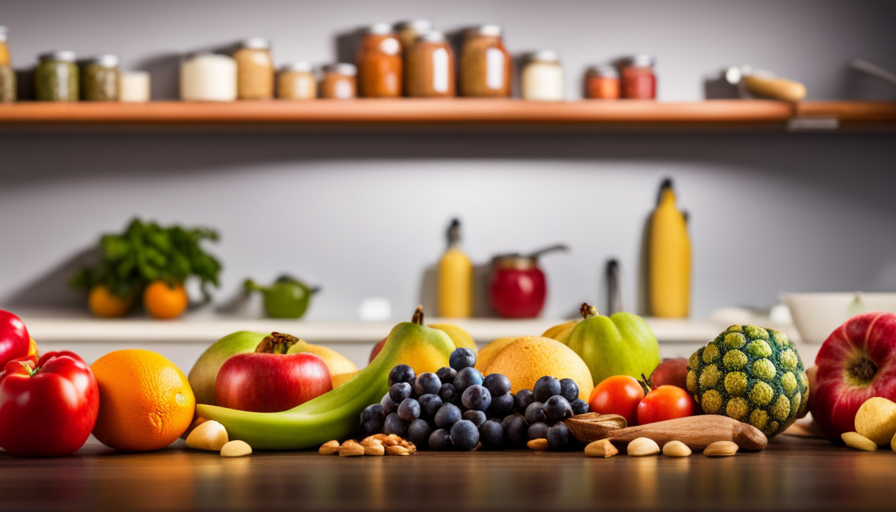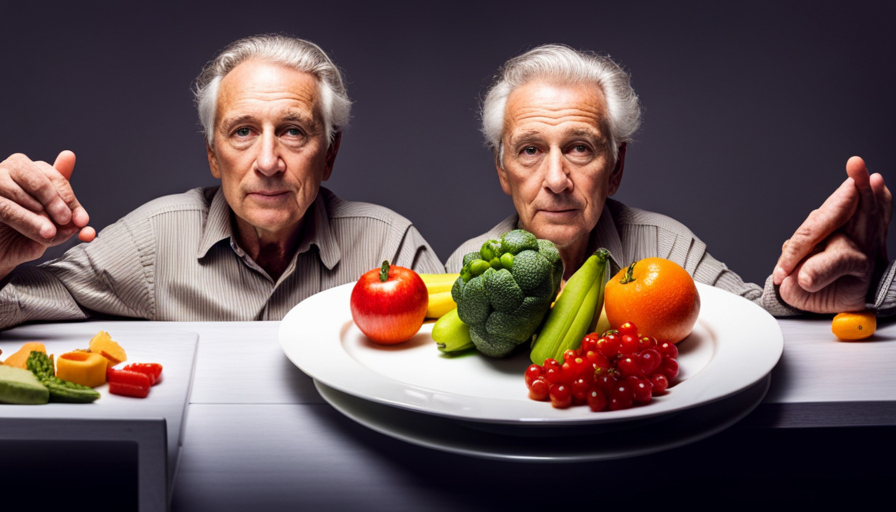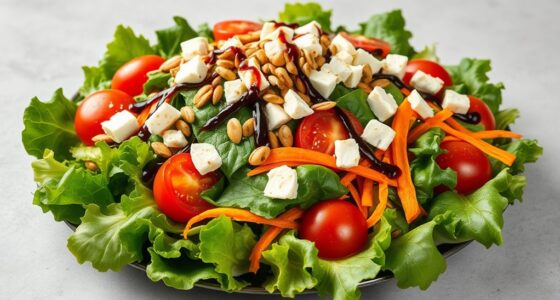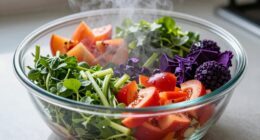“Food should be your medicine and medicine should be your food.” These insightful words from Hippocrates continue to resonate today, emphasizing the significance of fueling our bodies with nutritious, unprocessed elements.
If you’re considering embarking on a raw food diet, you’re taking a powerful step towards optimal health and vitality. As someone who has personally experienced the transformative benefits of this lifestyle, I am excited to guide you through the journey of starting a raw food diet.
In this article, we will explore the essential steps to get you started on the right path. Through education, stocking your kitchen, transitioning gradually, experimenting with recipes, staying hydrated, practicing food safety, listening to your body, seeking support, and embracing the numerous benefits of a raw food lifestyle, you will embark on a remarkable adventure of nourishment and self-discovery.
So, let’s dive in and uncover the secrets to thriving on a raw food diet!
Key Takeaways
- Education and guidance from healthcare professionals are important when starting a raw food diet.
- Gradual transition to a raw food diet is recommended for long-term success.
- Experimenting with raw food recipes can help satisfy cravings and discover alternatives.
- Including a wide range of fruits, vegetables, healthy fats, and proteins ensures essential nutrient intake in a raw food diet.
Educate Yourself on the Raw Food Diet
Before diving headfirst into a raw food diet, it’s crucial to educate yourself on the ins and outs of this transformative lifestyle. The raw food diet emphasizes the consumption of unprocessed, whole foods in their natural state. It promotes the belief that cooking destroys essential nutrients and enzymes, which are vital for optimal health.
Understanding the importance of nutrient balance is key when embarking on a raw food diet. While this way of eating can provide an abundance of vitamins, minerals, and antioxidants, it may also lead to potential health risks if not properly balanced. It’s essential to ensure you’re getting an adequate amount of protein, healthy fats, and carbohydrates from sources like nuts, seeds, avocados, and sprouted grains.
Educating yourself on the potential health risks associated with a raw food diet is equally important. Some individuals may experience difficulty in meeting their caloric needs, which can result in weight loss, fatigue, and nutrient deficiencies. It’s crucial to monitor your nutrient intake and seek guidance from a healthcare professional or registered dietitian to ensure you’re meeting your body’s requirements.
Transitioning to a raw food diet requires careful consideration and planning. Once you’ve educated yourself on the raw food lifestyle, it’s time to stock your kitchen with fresh fruits and vegetables.
Stock Your Kitchen with Fresh Fruits and Vegetables
To truly embrace the beauty of a raw lifestyle, fill your kitchen with an abundance of vibrant, nourishing fruits and vegetables. Stocking your kitchen with fresh produce is essential when starting a raw food diet. Not only does it provide the foundation for your meals, but it also ensures that you have a variety of options to choose from. Organic produce is highly recommended, as it is free from harmful pesticides and chemicals, and it offers more nutritional value. When buying fruits and vegetables, look for ones that are ripe and in season for maximum flavor and nutrient content.
To help you get started, here are some tips for storing fruits and vegetables:
-
Keep fruits and vegetables separate: Some fruits release ethylene gas, which can cause other produce to spoil faster. Store fruits and vegetables in separate compartments or containers to prevent this.
-
Store in the refrigerator: Most fruits and vegetables stay fresh longer when stored in the refrigerator. However, there are exceptions like bananas and tomatoes, which should be kept at room temperature.
-
Use breathable bags or containers: Fruits and vegetables need air circulation to stay fresh. Opt for breathable bags or containers, such as mesh produce bags or perforated plastic bags.
-
Check for freshness regularly: Regularly inspect your fruits and vegetables for any signs of spoilage. Remove any damaged or rotten pieces to prevent the spread of mold and bacteria.
By stocking your kitchen with fresh produce and following these storage tips, you’ll be well-prepared to embark on your raw food journey. Gradually transitioning to a raw food diet will be the next step in your path to health and wellness.
Gradually Transition to a Raw Food Diet
As you ease into the incredible world of embracing a raw lifestyle, you’ll find yourself gradually embracing the mouthwatering wonders of a diet filled with vibrant, nutrient-packed fruits and vegetables that’ll have your taste buds dancing with joy.
The transitioning process to a raw food diet is an essential step in ensuring long-term success and avoiding any potential challenges along the way. It’s important to remember that transitioning to a raw food diet isn’t an overnight process. Start by incorporating more raw foods into your meals gradually.
Begin by replacing one cooked meal with a raw meal each day. This could be a refreshing salad or a delicious smoothie filled with fresh fruits and leafy greens. As your body adjusts to this change, you can gradually increase the number of raw meals in your diet.
During the transitioning process, you might face some challenges. It’s common to experience cravings for cooked foods, especially if you’ve been eating them for a long time. To overcome this, try experimenting with different raw food recipes to find alternatives that satisfy your cravings.
For example, you can make raw versions of your favorite dishes, such as zucchini noodles with a flavorful tomato sauce. By gradually transitioning to a raw food diet and finding ways to overcome potential challenges, you’ll be better equipped to embrace this lifestyle fully.
So, let’s now dive into the next section and discover how to experiment with raw food recipes.
Experiment with Raw Food Recipes
Discover the endless possibilities and culinary creativity that await as you delve into the world of experimenting with raw food recipes. Raw food snacks and desserts can be just as delicious and satisfying as their cooked counterparts. By using fresh, whole ingredients and innovative techniques, you can create mouth-watering treats that’ll leave you feeling nourished and energized.
When it comes to raw food snacks, think beyond the typical carrot sticks and celery. Get creative with dehydrated fruits and vegetables, like crispy kale chips or zucchini noodles. You can also make your own raw energy bars using a combination of nuts, seeds, and dried fruits. These snacks aren’t only tasty but also packed with essential nutrients.
For those with a sweet tooth, raw food desserts offer a guilt-free indulgence. Try making a raw chocolate mousse using avocados, cacao powder, and sweeteners like dates or maple syrup. Or whip up a refreshing fruit sorbet using frozen fruits blended with a splash of coconut water. The possibilities are endless when it comes to raw food desserts.
As you embark on your raw food journey, don’t forget to stay hydrated with water and fresh juices. Hydration’s key to maintaining optimal health and digestion. So grab a glass of water or sip on a homemade green juice to quench your thirst and support your raw food lifestyle. Transitioning to a raw food diet takes time and patience, but with these delicious recipes, you’ll be well on your way to a vibrant and nourishing way of eating.
Stay Hydrated with Water and Fresh Juices
Quench your thirst and invigorate your body with the refreshing and revitalizing power of water and fresh juices. When starting a raw food diet, it’s crucial to stay hydrated to support your body’s functions and maintain optimal health. While both water and fresh juices are excellent choices, they offer different benefits.
Water is essential for our bodies to function properly. It helps with digestion, nutrient absorption, and detoxification. Drinking an adequate amount of water throughout the day can also improve skin health, boost energy levels, and promote weight loss.
On the other hand, fresh juices provide not only hydration but also a plethora of vitamins, minerals, and antioxidants. They can help boost your immune system, improve digestion, and provide a natural source of energy.
Staying hydrated has numerous benefits, including improved overall health and enhanced physical performance. It can also help regulate body temperature, lubricate joints, and support organ function. Additionally, staying hydrated can aid in weight management by reducing hunger and cravings.
To incorporate healthy fats and proteins into your diet, consider adding avocados, nuts, seeds, and plant-based protein sources such as tofu or tempeh. These nutrient-rich foods will provide essential fatty acids, amino acids, and other vital nutrients necessary for a balanced raw food diet.
Transitioning into incorporating healthy fats and proteins into your diet will further enhance your raw food journey and support your body’s needs.
Incorporate Healthy Fats and Proteins into Your Diet
To maintain a healthy raw food diet, it’s crucial to incorporate a variety of healthy fats and proteins into your meals. While fruits and vegetables are the foundation of a raw food diet, healthy fats and proteins play a vital role in providing essential nutrients and keeping you satisfied.
Including a variety of healthy fats in your diet, such as avocados, nuts, and seeds, can help promote heart health and provide you with a good source of energy. These fats are also rich in omega-3 fatty acids, which are important for brain function and reducing inflammation.
Proteins are essential for building and repairing tissues, as well as supporting a healthy immune system. Incorporating plant-based proteins such as legumes, tofu, and tempeh can ensure that you’re getting enough protein in your raw food diet.
Incorporating healthy fats and proteins into your raw food diet isn’t just about meeting your nutritional needs but also about adding variety and flavor to your meals. By including a wide range of fruits, vegetables, healthy fats, and proteins, you can ensure that you’re getting all the essential nutrients your body needs to thrive on a raw food diet.
Next, it’s important to be mindful of food safety and hygiene practices to prevent any potential risks or contamination.
Be Mindful of Food Safety and Hygiene Practices
Make sure you prioritize food safety and hygiene practices to protect yourself and your loved ones from any potential risks or contamination while following a raw food lifestyle. When consuming raw foods, it is important to be extra cautious as they are not cooked, which eliminates potential bacteria and pathogens. To ensure food safety, always wash your fruits and vegetables thoroughly before consumption. Use a scrub brush to remove any dirt or debris, and rinse them under running water. Additionally, practice proper handling and storage techniques to prevent cross-contamination. Keep raw foods separate from cooked foods and use separate cutting boards and utensils. It is also essential to store perishable raw foods, such as sprouts or raw dairy products, at the appropriate temperature to prevent spoilage.
To further emphasize the importance of food safety and hygiene practices, let’s take a look at the following table:
| Food Safety Tips | Hygiene Practices |
|---|---|
| Wash fruits and vegetables | Clean hands before eating |
| Separate raw and cooked foods | Use clean utensils |
| Store perishable foods correctly | Keep kitchen surfaces clean |
By following these guidelines, you can minimize the risk of foodborne illnesses and ensure that your raw food diet is safe and healthy. Remember, it is crucial to listen to your body’s needs and adjust accordingly, which we will explore in the next section.
Listen to Your Body’s Needs and Adjust Accordingly
As I mentioned earlier, it’s crucial to be mindful of food safety and hygiene practices when starting a raw food diet. However, it’s equally important to listen to your body’s needs and adjust your approach accordingly.
Each person is unique, and what works for one individual may not work for another. That’s why adopting a personalized approach is key.
Adjusting habits is an essential part of any dietary change, and transitioning to a raw food diet is no exception. Pay attention to how your body responds to different foods and make modifications as needed.
For example, if you find that certain raw foods cause digestive discomfort, try incorporating them in smaller amounts or exploring alternative options. On the other hand, if you feel energized and satisfied after consuming certain raw foods, consider including them more frequently in your meals.
Remember, this journey is about discovering what works best for you and your body. It may take some trial and error, but with time and patience, you’ll find a raw food approach that suits your individual needs.
Now, let’s move on to the next section and explore how seeking support and guidance from raw food communities can enhance your experience on this journey.
Seek Support and Guidance from Raw Food Communities
Joining raw food communities will provide you with the support and guidance you need to enhance your experience on this journey. Raw food community events are a great way to connect with like-minded individuals who are also following a raw food diet. These events often include workshops, cooking demonstrations, and potluck meals, where you can learn new recipes and techniques for preparing raw meals.
Being surrounded by others who share your passion for raw food can be incredibly motivating and inspiring. Additionally, raw food communities offer a platform for sharing experiences and challenges that come with a raw food diet. It can be helpful to hear about others’ struggles and successes, as it reminds you that you are not alone in your journey. You can seek advice and tips from more experienced members, who can offer guidance on meal planning, dealing with cravings, and overcoming obstacles.
By actively participating in raw food community events and engaging with fellow raw food enthusiasts, you can build a strong support system that will keep you motivated and accountable. This sense of community can make your transition to a raw food lifestyle much smoother and enjoyable.
Now, let’s transition into the next section about embracing the benefits of a raw food lifestyle.
Embrace the Benefits of a Raw Food Lifestyle
When starting a raw food diet, it’s crucial to seek support and guidance from raw food communities. These communities provide a wealth of information and firsthand experiences that can help you navigate the challenges and reap the benefits of a raw food lifestyle.
Now, let’s talk about the benefits of embracing a raw food lifestyle.
One significant benefit of a raw food diet is its potential for weight loss. Raw foods are typically low in calories and high in fiber, which can help you feel full and satisfied while consuming fewer calories. Additionally, raw foods are rich in water content, which further aids in weight management. Studies have shown that individuals who follow a raw food diet tend to have lower body mass indexes (BMIs) and reduced waist circumference.
Another advantage of a raw food diet is its positive impact on digestion. Raw foods are packed with enzymes that aid in the breakdown of food, making it easier for your body to digest and absorb nutrients. Moreover, raw foods are typically high in fiber, which promotes healthy bowel movements and prevents constipation.
A raw food diet can be beneficial for weight loss and digestion. By incorporating more raw fruits, vegetables, nuts, and seeds into your diet, you can enjoy these advantages while nourishing your body with wholesome, nutrient-rich foods.
Frequently Asked Questions
Can I still eat cooked food occasionally while following a raw food diet?
Yes, you can still enjoy cooked food occasionally while following a raw food diet. However, it’s important to note that the main focus of a raw food diet is to consume foods in their natural, uncooked state to maximize nutrient intake. When choosing cooked food alternatives, opt for steamed or lightly cooked options to preserve as many nutrients as possible.
Remember, the benefits of a raw food diet include increased energy, improved digestion, and enhanced nutrient absorption.
What are some common challenges or difficulties people experience when transitioning to a raw food diet?
Transitioning to a raw food diet can present some common challenges and difficulties. One of the most common challenges is the adjustment to a new way of eating. It can be tough to give up cooked foods and rely solely on raw fruits, vegetables, and nuts.
Additionally, sourcing and preparing raw food can be time-consuming and require careful planning. However, with patience and a commitment to your health, these challenges can be overcome.
Are there any specific vitamins or nutrients that I need to be mindful of when following a raw food diet?
When following a raw food diet, it’s important to be mindful of specific vitamins and nutrients. Some nutrients that may require attention include vitamin B12, iron, calcium, and omega-3 fatty acids. Since raw food diets often exclude animal products, it can be challenging to obtain adequate amounts of these nutrients. Therefore, it’s recommended to include fortified foods or consider supplements to ensure proper intake. Consulting with a healthcare professional or registered dietitian can also provide guidance on meeting nutrient needs.
Can I still eat out at restaurants while following a raw food diet?
When dining out on a raw food diet, it’s important to plan ahead and communicate with the restaurant staff. Interestingly, only 3% of restaurants offer a dedicated raw food menu. To navigate social settings, look for restaurants with salad bars, sushi options, or vegan eateries that may have raw food choices. Call ahead to inquire about menu options and if they can accommodate your dietary preferences. Remember to bring your own dressings or toppings if needed.
How can I ensure I am getting enough protein on a raw food diet?
To ensure I’m getting enough protein on a raw food diet, I can focus on incorporating various raw food protein sources into my meals. Some excellent options include nuts, seeds, legumes, and leafy greens. These foods provide essential amino acids and can be easily incorporated into salads, smoothies, or raw food recipes.
Additionally, I can consider adding plant-based protein powders or supplements to boost my protein intake if needed.
Are there any tips for transitioning to a raw food diet for people who don’t typically enjoy raw food?
Transitioning to a raw food diet can be challenging for those who don’t typically enjoy raw food. However, there are tips to make the switch easier. Try incorporating familiar flavors into your meals and focus on finding raw food recipes that appeal to your taste buds.
Conclusion
In conclusion, embarking on a raw food diet is a transformative journey that can bring about remarkable changes in our health and well-being. By nourishing our bodies with vibrant and nutrient-dense fruits and vegetables, we’re giving ourselves the gift of vitality and vitality.
As we savor the crispness of a juicy apple or the vibrant colors of a fresh salad, we’re not only fueling our bodies but also engaging in a sensory experience that awakens our senses and connects us to the beauty of nature.
So let’s embrace this raw food lifestyle, and let the colors and flavors of nature nourish our bodies and souls.










